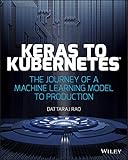Keras to Kubernetes : the journey of a machine learning model to production / Dattaraj Jagdish Rao.
Material type: TextPublisher: Indianapolis, IN : John Wiley & Sons, [2019]Description: 1 online resource (xviii, 302 pages)Content type:
TextPublisher: Indianapolis, IN : John Wiley & Sons, [2019]Description: 1 online resource (xviii, 302 pages)Content type: - text
- computer
- online resource
- 9781119564874
- 1119564875
- 9781119564843
- 1119564840
- 006.3/1 23
- Q325.5 .R36 2019
Description based on online resource; title from digital title page (viewed on August 08, 2019).
Includes bibliographical references and index.
Build a Keras model to scale and deploy on a Kubernetes cluster. We have seen an exponential growth in the use of Artificial Intelligence (AI) over last few years. AI is becoming the new electricity and is touching every industry from retail to manufacturing to healthcare to entertainment. Within AI, we're seeing a particular growth in Machine Learning (ML) and Deep Learning (DL) applications. ML is all about learning relationships from labeled (Supervised) or unlabeled data (Unsupervised). DL has many layers of learning and can extract patterns from unstructured data like images, video, audio, etc. Keras to Kubernetes: The Journey of a Machine Learning Model to Production takes you through real-world examples of building DL models in Keras for recognizing product logos in images and extracting sentiment from text. You will then take that trained model and package it as a web application container before learning how to deploy this model at scale on a Kubernetes cluster. You will understand the different practical steps involved in real-world ML implementations which go beyond the algorithms.
Cover; Title Page; Copyright; Acknowledgments; About the Author; About the Technical Editor; Credits; Contents; Introduction; How This Book Is Organized; Conventions Used; Who Should Read This Book; Tools You Will Need; Using Python; Using the Frameworks; Setting Up a Notebook; Finding a Dataset; Summary; Chapter 1 Big Data and Artificial Intelligence; Data Is the New Oil and AI Is the New Electricity; Rise of the Machines; Exponential Growth in Processing; A New Breed of Analytics; What Makes AI So Special; Applications of Artificial Intelligence; Building Analytics on Data
Types of Analytics: Based on the ApplicationTypes of Analytics: Based on Decision Logic; Building an Analytics-Driven System; Summary; Chapter 2 Machine Learning; Finding Patterns in Data; The Awesome Machine Learning Community; Types of Machine Learning Techniques; Unsupervised Machine Learning; Supervised Machine Learning; Reinforcement Learning; Solving a Simple Problem; Unsupervised Learning; Supervised Learning: Linear Regression; Gradient Descent Optimization; Applying Gradient Descent to Linear Regression; Supervised Learning: Classification; Analyzing a Bigger Dataset
Metrics for Accuracy: Precision and RecallComparison of Classification Methods; Bias vs. Variance: Underfitting vs. Overfitting; Reinforcement Learning; Model-Based RL; Model-Free RL; Summary; Chapter 3 Handling Unstructured Data; Structured vs. Unstructured Data; Making Sense of Images; Dealing with Videos; Handling Textual Data; Listening to Sound; Summary; Chapter 4 Deep Learning Using Keras; Handling Unstructured Data; Neural Networks; Back-Propagation and Gradient Descent; Batch vs. Stochastic Gradient Descent; Neural Network Architectures; Welcome to TensorFlow and Keras
Bias vs. Variance: Underfitting vs. OverfittingSummary; Chapter 5 Advanced Deep Learning; The Rise of Deep Learning Models; New Kinds of Network Layers; Convolution Layer; Pooling Layer; Dropout Layer; Batch Normalization Layer; Building a Deep Network for Classifying Fashion Images; CNN Architectures and Hyper-Parameters; Making Predictions Using a Pretrained VGG Model; Data Augmentation and Transfer Learning; A Real Classification Problem: Pepsi vs. Coke; Recurrent Neural Networks; Summary; Chapter 6 Cutting-Edge Deep Learning Projects; Neural Style Transfer; Generating Images Using AI
Credit Card Fraud Detection with AutoencodersSummary; Chapter 7 AI in the Modern Software World; A Quick Look at Modern Software Needs; How AI Fits into Modern Software Development; Simple to Fancy Web Applications; The Rise of Cloud Computing; Containers and CaaS; Microservices Architecture with Containers; Kubernetes: A CaaS Solution for Infrastructure Concerns; Summary; Chapter 8 Deploying AI Models as Microservices; Building a Simple Microservice with Docker and Kubernetes; Adding AI Smarts to Your App; Packaging the App as a Container; Pushing a Docker Image to a Repository
There are no comments on this title.
